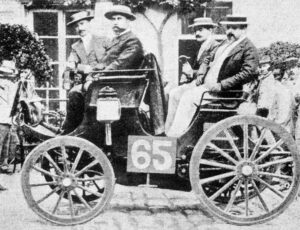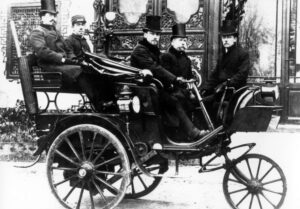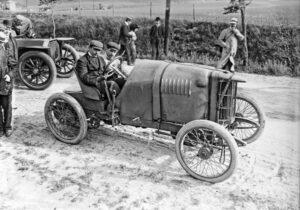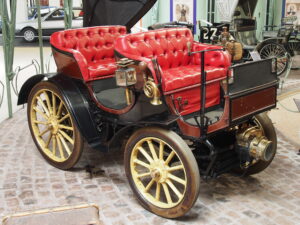Peugeot History
Peugeot is a major French car brand, part of PSA Peugeot Citroën, the second-largest carmaker based in Europe.
The family business that precedes the current Peugeot company was founded in 1810 and manufactured coffee mills and bicycles. On 20 November 1858, Emile Peugeot applied for the lion trademark. Armand Peugeot built the concern’s first car, an unreliable steam tricycle, in collaboration with Leon Serpollet in 1889; this was followed in 1890 by an internal combustion car with a Panhard-Daimler engine. Due to family discord, Armand Peugeot 1896 founded the Société des Automobiles Peugeot. The Peugeot company and family is originally from Sochaux, France. Peugeot retains a large manufacturing plant and Peugeot Museum there. It also sponsors the Sochaux football club, founded in 1928 by a member of the Peugeot family.

The Peugeot family of Valentigney, Montbéliard, Franche-Comté, France, began in the manufacturing business in the 18th century. In 1842, they added the production of coffee, pepper, and salt grinders. The company’s entry into the vehicle market was by means of crinoline dresses, which used steel rods, leading to umbrella frames, saw blades, wire wheels, and ultimately bicycles. Armand Peugeot introduced his “Le Grand Bi” penny-farthing in 1882, along with a range of other bicycles. Peugeot bicycles continued to be built until very recently, although the car company and bike company parted ways in 1926.

First Peugeot Automobile “1889”
Armand Peugeot became interested in the automobile early on and, after meeting with Gottlieb Daimler and others, was convinced of its viability. The first Peugeot automobile, a three-wheeled steam-powered car designed by Léon Serpollet, was produced in 1889; only four examples were made. Steam power was heavy and bulky and required lengthy warmup times. In 1890, after meeting Gottlieb Daimler and Émile Levassor, steam was abandoned in favor of a four-wheeled car with a petrol-fuelled internal combustion engine built by Panhard under Daimler license. The car was more sophisticated than many of its contemporaries, with a three-point suspension and a sliding-gear transmission

Peugeot was the first car company to fit rubber tires
More cars followed, twenty-nine being built in 1892, forty in 1894, seventy-two in 1895, 156 in 1898, and three hundred in 1899. These early models were given “Type” numbers with the Type 12, for example, dating from 1895. Peugeot became the first manufacturer to fit rubber tires (solid, rather than pneumatic) to a petrol-powered car that year

Peugeot was the first to win a car race
Peugeot was an early pioneer in motor racing with Albert Lemaître winning the world’s first motor race, the 1894 Paris-Rouen race, in a 3 hp Peugeot. Five Peugeots qualified for the main event, and all finished. Lemaitre finished 3 minutes 30 seconds behind the Comte de Dion whose steam-powered car was ineligible for the official competition. Three Peugeots were entered in the 1895 Paris-Bordeaux where they were beaten by Panhard’s car (despite an average speed of 20.8 km/h (12.9 mph) and taking the 31,500 franc prize. This also marked the debut of Michelin pneumatic tires in racing, also on a Peugeot; they proved insufficiently durable. Nevertheless, the vehicles were still very much horseless carriages in appearance and were steered by a tiller.

8HP Peugeot type 15 “1896”
1896 saw the first Peugeot engines built; no longer were they reliant on Daimler. Designed by Rigoulot, the first engine was an 8 hp (6.0 kW) horizontal twin fitted to the back of Type 15. It also served as the basis of a nearly exact copy produced by Rochet-Schneider. Further improvements followed: the engine moved to the front on Type 48 and was soon under a hood (bonnet) at the front of the car, instead of hidden underneath; the steering wheel was adopted on Type 36, and they began to look more like the modern car.
How did it start?
1810 as a coffee mill company
1830 as a bicycle manufacturer
1882 as a car manufacturer
1898 as a motorcycle company
1926 as a separate company

